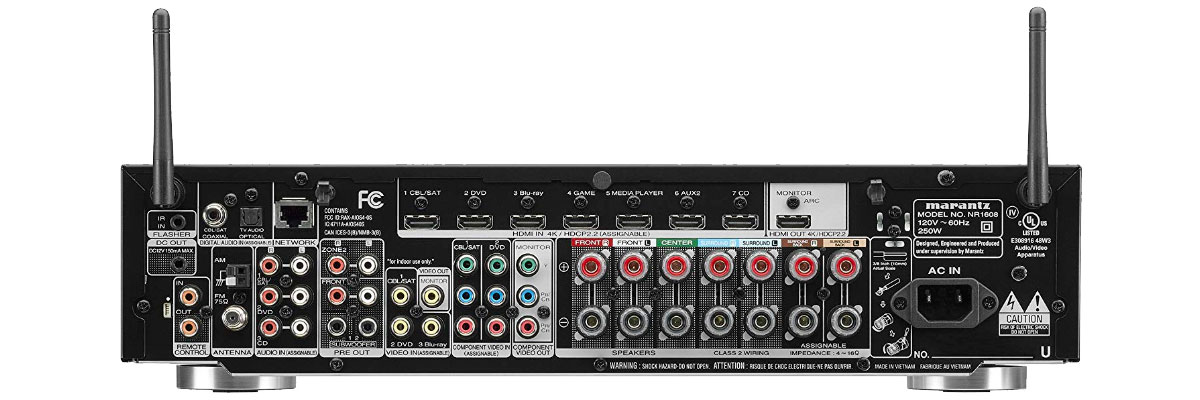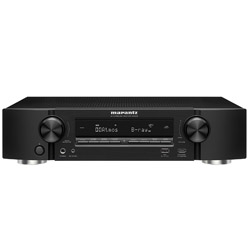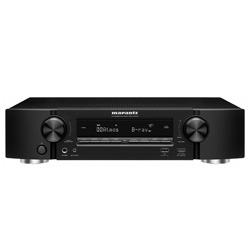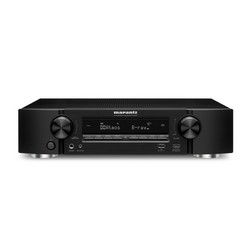 AV receivers have a reputation for such large and heavy drawers, which take up a lot of space on the shelf, but, in fact, you do not need such a huge device to organize a real home theater at your place, especially in a medium-sized room. An ultra-thin model of the AV receiver, such as the Marantz NR1608, can do the job perfectly. Intrigued to see Marantz NR1608 specs? Follow our Marantz NR1608 review.
AV receivers have a reputation for such large and heavy drawers, which take up a lot of space on the shelf, but, in fact, you do not need such a huge device to organize a real home theater at your place, especially in a medium-sized room. An ultra-thin model of the AV receiver, such as the Marantz NR1608, can do the job perfectly. Intrigued to see Marantz NR1608 specs? Follow our Marantz NR1608 review.
Marantz NR1608 review
Features
The 7.2-channel Marantz NR1608 model can work with the currently relevant 3D-sound formats Dolby Atmos (in 5.1.2-configuration) and DTS: X, as well as with DTS Neural: X. The model is equipped with seven discrete high-current amplifiers with a capacity of 70 W (6 Ohms) each.
Design and build
Marantz NR1608 occupies a top position in the corporate slim line of AV receivers with a low body, which perfectly match the design with modern TVs. The AV receiver is charged with wireless technology and can act as a streamer. On board there is Bluetooth, Airplay and Wi-Fi (two ranges). There is a possibility of LAN or WLAN connection to a local network. Through it and the USB port built into the front panel, Hi-Res-audio playback in FLAC, ALAC, AIFF or WAV, as well as DSD (2.8 / 5.6 MHz) is available.

Connectivity
All eight HDMI inputs of the receiver support 4K-video UHD (60 Hz), HDCP 2.2, Dolby Vision (12-bit color depth and dynamic metadata support) and HDR10, 4: 4: 4 Pure Color, etc. Among the Marantz NR1608 connectors, one can distinguish the presence of outputs for two subwoofers, as well as for zone 2. There are optical and coaxial inputs, and seven pairs of color-coded screw terminals are used to connect speakers.
Setup
Audyssey MultEQ is used to calibrate speakers (the package includes Dynamic Volume and Dynamic EQ technologies to optimize signal level and frequency response), and the professional standard ISF is used to calibrate video. For a fee, you can download the Audyssey MultEQ Editor application for fine-tuning the results of the MultEQ system. With the new firmware, access to the use of the Hybrid Log-Gamma format (HLG, hybrid logarithmic gamma function), developed for HDR broadcasts, is opened.
Pros and Cons
Pros
- What drove me to this unit was the flexibility to pre-out the mains to an external amplifier
- The core brains are solid and reliable. It supports all the current audio and video codecs
Cons
- Auto sound tuning is horrible. Spend some time to manually calibrate sound to suit that hall
Common features
Product
Model
Brand
Reviews
Amplifier
Channels
Stereo power (RMS), W/Ohm
Output impedance, Ohm
Frequency response
THD in stereo, %
Audio features
Digital to analog converter (DAC)
Bi-amping
Pure direct (straight)
Auto speaker calibration
Speaker A/B switching
Other audio features
Connectivity
Wi-Fi
USB
Bluetooth
Ethernet (RJ45)
DLNA
MHL
Streaming services
Apple Music (AirPlay)
Amazon Music
Spotify
Other streaming services
Extensive connection
HDMI input/output
HDMI ARC (Audio Return Channel)
HDMI eARC (Enhanced Audio Return Channel)
HDMI CEC
Digital content protection (HDCP)
Subwoofer output (LFE)
Headphone output
Optical digital input
Coaxial digital input
Composite input
Component input/output
Phono (MM) input
Front panel connectors
Multi channel preamp output
Video features
HDR (High Dynamic Range)
4K signal pass-through
8K signal pass-through
HDMI signal pass-through
3D signal pass-through
HDMI pass-through in standby mode
Video conversion
Analog to HDMI scaling
HDMI to HDMI scaling
Dolby Vision
Other video features
Additional features
Voice control
App control
Display
Tuner
Sleep timer
Auto power off
ECO mode
Graphical user interface (GUI)
Setup assistant
Firmware update
Other additional features
Multi-room
Multi-room zones
Zone audio output
Zone HDMI output
Multi-room control
RS-232
Remote control input/output (IR)
DC trigger output (12V)
Multichannel surround
Dolby Atmos
Dolby TrueHD
Dolby Surround
Dolby (other)
DTS:X
DTS HD Master
DTS Virtual:X
DTS Neural:X
DTS (other)
Auro-3D
IMAX Enhanced
Multichannel stereo
Audio file formats
MP3
WMA
AAC
WAV
FLAC
ALAC
Other audio file formats
Power
Operational power consumption, W
Standby consumption, W
Removable power cord
User manual
Manual
Dimensions
Size W x H x D, cm/inches
Weight, kg/lbs
Other
Release year




